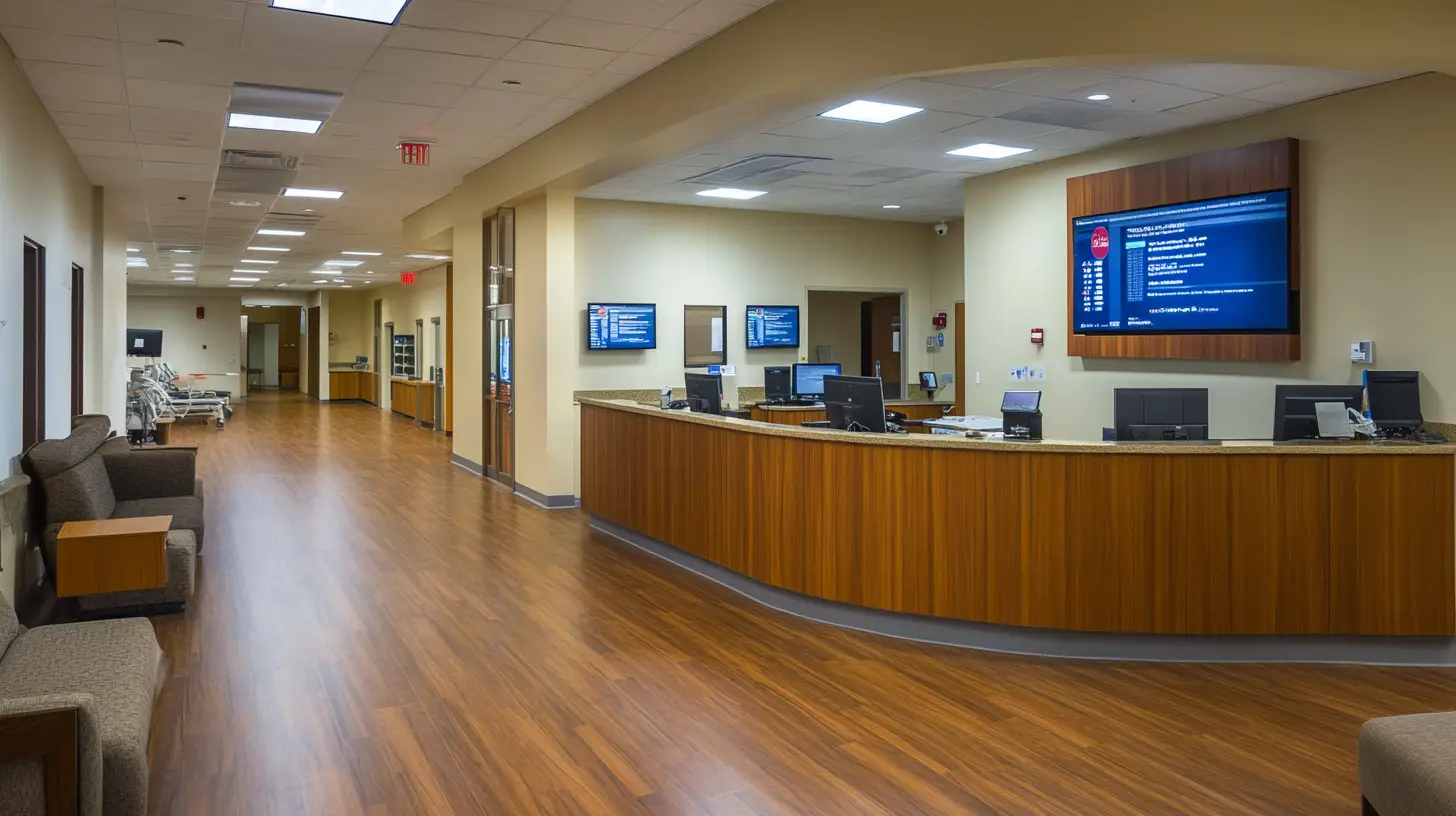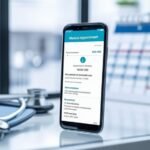You’re leveraging digital patient data display systems to enhance healthcare efficiency. These systems update patient data instantly, improve communication, and streamline information sharing. Real-time access to data optimizes patient outcomes and operational performance. By centralizing patient information and schedules, workflows are streamlined, reducing errors and improving care coordination. Security is paramount, with compliance to standards like HIPAA ensuring data integrity. Future innovations will integrate real-time updates, personalized displays, and interactive features, further advancing patient care. To understand the full spectrum of advantages these systems offer, there’s much more to explore.
Key Takeaways
- Digital patient data display systems provide real-time updates to enhance communication and patient care.
- These systems streamline workflows by centralizing patient information and schedules in one accessible location.
- Enhanced security features ensure compliance with industry standards like HIPAA to protect patient data.
- Integration with electronic health records offers up-to-date and personalized patient information displays.
- Future innovations include interactive touch screens and AI-driven predictive analytics for improved patient experiences.
Importance in Healthcare
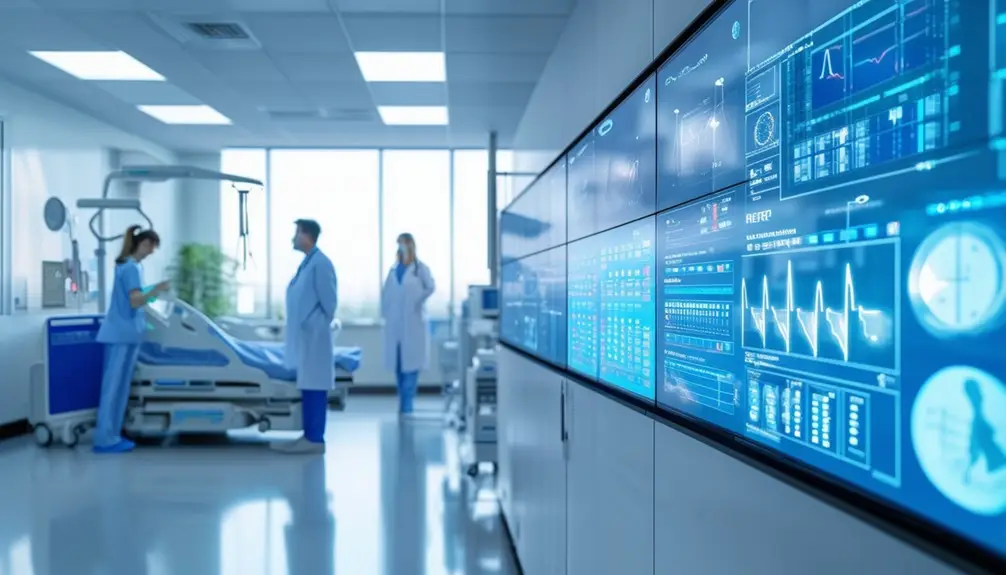
By streamlining information sharing and enhancing care coordination, digital patient data display systems have become essential to modern healthcare operations. You’ll find that these systems greatly enhance the efficiency of the healthcare system by improving communication between medical staff, patients, and visitors. Digital signage plays a vital role in this process, ensuring that all parties receive timely updates on appointments, waiting times, and health information.
When you walk into a healthcare facility equipped with these systems, you’ll notice how the patient experience improves. Interactive maps and directions on digital displays simplify wayfinding within large medical campuses, reducing stress and confusion for patients and visitors alike. This ease of navigation directly correlates to a more pleasant and efficient visit, as individuals can quickly locate their destinations.
Digital signage also promotes health education, disease prevention, and wellness programs. By providing accessible, real-time information on these topics, these systems foster a culture of wellness within the community. To sum up, digital patient data display systems are not just technological advancements; they are essential tools that enhance the operational efficiency of the healthcare system and greatly improve the patient experience.
Real-time Information Access
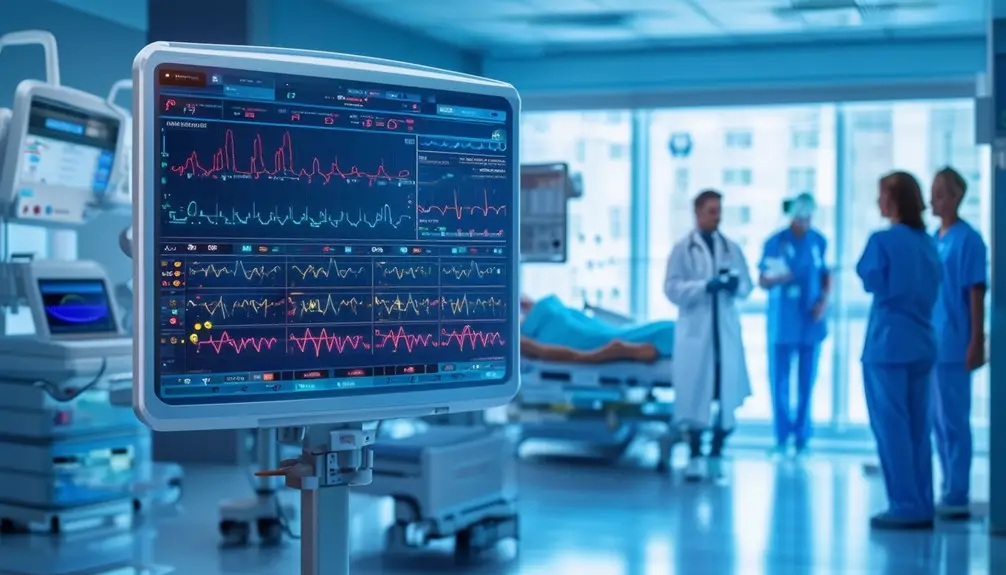
With real-time information access, you can update patient data instantly, ensuring accuracy and promptness in care. This capability enhances communication channels among healthcare staff, reducing the chances of errors and improving workflow efficiency. Additionally, streamlined information sharing keeps everyone informed and aligned, optimizing patient outcomes and operational performance.
Instant Data Updates
Instant data updates on digital patient data display systems greatly enhance real-time information access, streamlining communication and improving operational efficiency in healthcare settings. These systems guarantee that patients, visitors, and staff have immediate access to critical information, making hospital operations smoother.
With seamless integration into existing hospital infrastructure, these digital displays can instantly update waiting times, appointment schedules, and important announcements. This level of real-time information access is essential for improving patient and visitor experience. For instance, patients can navigate medical campuses easily using interactive maps and directions displayed on these systems.
| Feature | Benefit |
|---|---|
| Waiting Time Updates | Reduces patient anxiety and uncertainty |
| Appointment Schedules | Enhances punctuality and reduces delays |
| Interactive Maps | Simplifies navigation for patients |
| Instant Announcements | Keeps everyone informed promptly |
Hospital staff also benefit from these instant data updates. They can communicate efficiently with patients and visitors by displaying real-time updates on digital signage, ensuring everyone is informed and engaged. This not only enhances operational efficiency but also elevates the overall standard of patient care. Incorporating such systems with Rights Reserved guarantees that the technology is protected and proprietary, maintaining its unique benefits for your healthcare facility.
Enhanced Communication Channels
Harnessing the power of digital patient data display systems, healthcare facilities can greatly enhance communication channels by providing up-to-the-minute information access to both staff and patients. Real-time updates on waiting times, appointments, and facility information guarantee that everyone remains informed and coordinated. You’ll find that these systems allow hospital staff to efficiently update and disseminate critical information, leading to improved operations and a smoother workflow.
Patients benefit significantly as well. Interactive maps and directions make finding their way through intricate healthcare facilities easier, reducing stress and confusion. This seamless access to real-time information elevates the overall patient experience, as patients are less likely to feel lost or uninformed during their visit.
From a technical standpoint, these systems utilize robust networks and data integration methods to ensure that updates are instantaneous and accurate. The ability to provide real-time information diminishes the risk of miscommunication and enhances the reliability of the data being shared. By streamlining communication channels, digital patient data display systems not only improve operational efficiency but also promote a more transparent and responsive healthcare environment. This level of enhanced communication is essential for maintaining high standards of patient care and satisfaction.
Streamlined Information Sharing
Digital patient data display systems revolutionize real-time information sharing by providing healthcare staff with immediate access to critical patient data and facility updates. These systems streamline the flow of information, guaranteeing that everyone from doctors to nurses can access the most current and relevant data without delay. By integrating electronic health records (EHRs) and other medical systems, these digital displays facilitate instant updates on patient status, lab results, and treatment plans.
These systems aren’t just for staff. Patients and visitors benefit from real-time access to updated waiting times, appointment schedules, and important announcements. Waiting rooms equipped with these displays can alleviate anxiety by keeping everyone informed about delays or changes in schedules. This transparency improves patient satisfaction and helps manage expectations.
Technically, the systems employ secure, encrypted networks to safeguard data integrity and confidentiality. With real-time syncing, any updates made in patient records are immediately reflected across all connected displays. This synchronization eliminates the inefficiencies and risks associated with outdated or miscommunicated information.
Digital patient data display systems enhance operational efficiency and elevate the overall healthcare experience. By guaranteeing that critical information is always up-to-date and easily accessible, these systems contribute to better patient care and streamlined facility operations.
Enhancing Patient Care
By integrating real-time information and interactive displays into healthcare settings, digital patient data display systems greatly enhance patient care and streamline communication among medical staff, patients, and visitors. These systems guarantee that patients receive timely updates about their care, reducing uncertainty and anxiety. You’ll find that the use of engaging and informative content displayed on digital signage can greatly improve patients’ overall experience.
Interactive displays also play an essential role in wayfinding within hospitals. With digital maps and directions, patients and visitors can easily navigate complex medical campuses, minimizing stress and delays. This efficient navigation contributes directly to a better patient experience.
Moreover, digital patient data display systems are instrumental in promoting health education. Healthcare institutions can use these platforms to disseminate information about wellness programs and disease prevention, fostering a culture of wellness within the community. The continuous exposure to educational content encourages healthier lifestyles and informed decision-making among patients.
The integration of Zoney digital signage into healthcare settings not only enhances patient care but also fosters effective communication. Through real-time updates and interactive content, these systems guarantee that patients, visitors, and staff are always informed and engaged, resulting in a more cohesive and supportive healthcare environment.
Streamlining Workflows
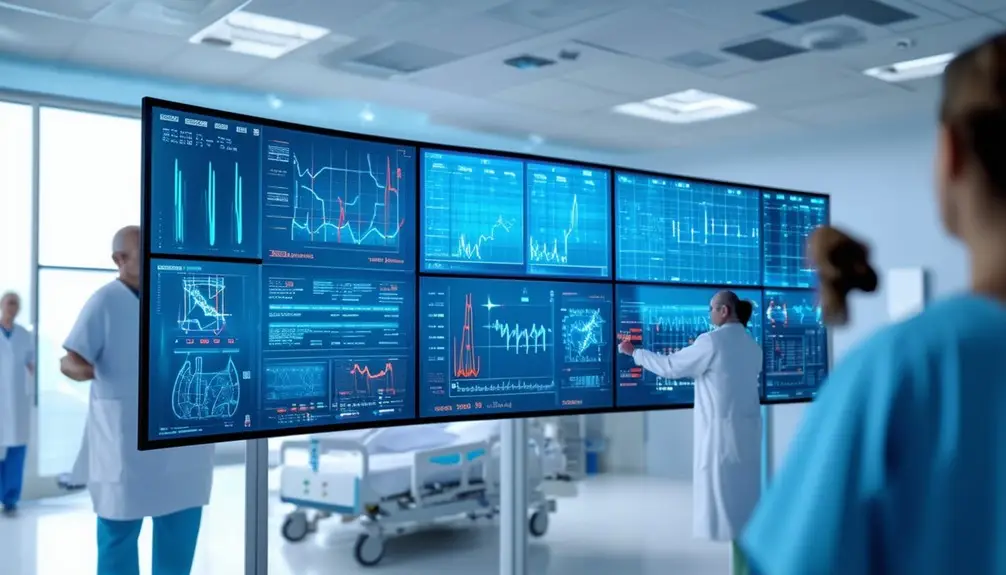
Real-time data displays greatly streamline workflows for healthcare staff by centralizing patient information and schedules, thereby enhancing operational efficiency. With digital patient data display systems, you’re able to see patient data, appointment schedules, and treatment plans all in one place. This centralization minimizes errors and improves communication among staff.
Consider the impact on daily operations:
| Benefit | Emotional Impact |
|---|---|
| Reduced Errors | Increased Confidence |
| Improved Communication | Enhanced Team Morale |
| Efficient Scheduling | Reduced Stress |
These systems allow you to access and update patient information easily, which enhances coordination of care and leads to better patient outcomes. Real-time updates guarantee that everyone on the healthcare team is on the same page, minimizing the risk of miscommunication. This not only contributes to a more organized and effective healthcare environment but also helps you provide better care for your patients.
Integration and Security
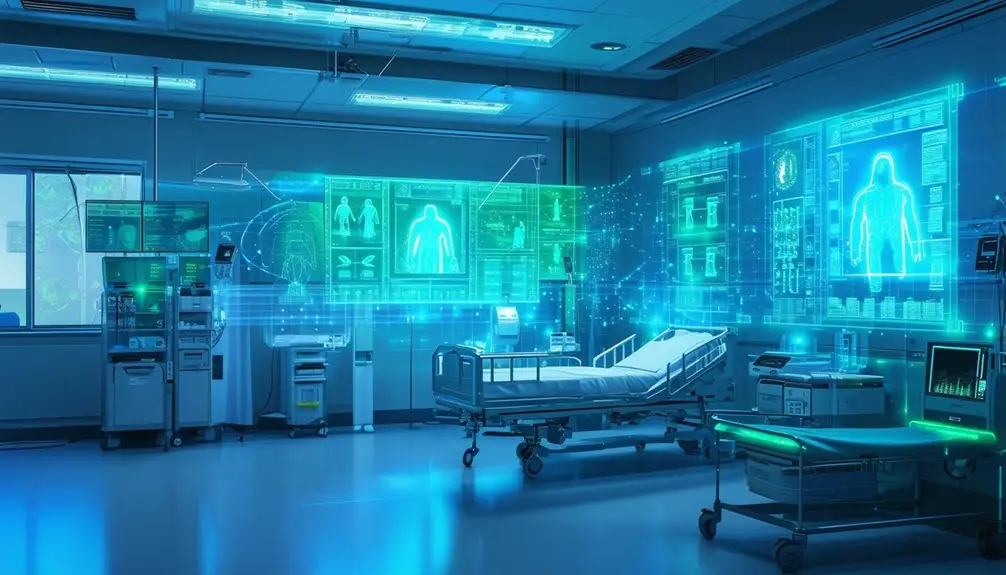
Ensuring that digital patient data display systems integrate smoothly with existing HR platforms and adhere to strict security protocols is essential for maintaining operational efficiency and protecting sensitive information. Data Display’s custom software not only drives the necessary hardware but also guarantees that all data displayed is secure and compliant with healthcare regulations.
To achieve seamless integration and high-quality security, Data Display focuses on:
- Tailored Software Solutions: Customized software designed to meet specific healthcare needs and guarantee compatibility with HR platforms.
- Regulatory Compliance: Following industry standards such as HIPAA to safeguard patient information.
- Secure Data Display: Implementing strong security measures to prevent unauthorized access and data breaches.
- Integration of Hardware and Software: Using proprietary technology to ensure that hardware and software work together seamlessly for dependable data display.
Future Innovations
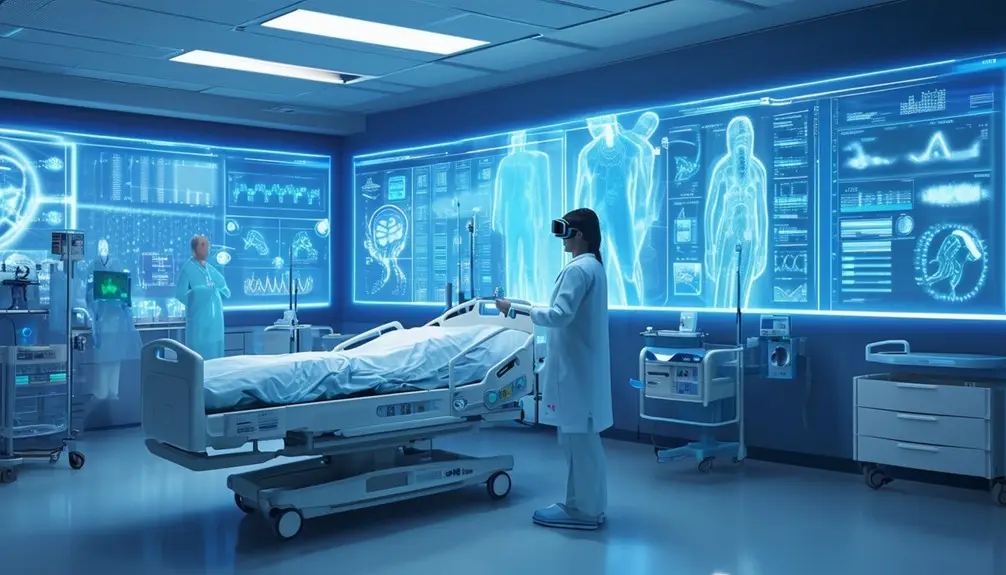
As digital patient data display systems evolve, future innovations will focus on integrating advanced features such as real-time updates, personalized displays, and interactive touch screens to enhance patient engagement and care. You’ll see systems increasingly synchronized with electronic health records, ensuring that patient data is updated in real-time. This means healthcare providers can make more informed decisions based on the most current information available.
Personalized displays will tailor the information shown according to individual patient needs and preferences. For instance, a patient with diabetes might see their recent blood sugar levels, medication reminders, and dietary recommendations. These personalized interfaces aim to make data more relevant and actionable for each patient.
Interactive touch screens will become a standard feature, allowing patients to access educational content and communicate directly with their healthcare providers. This interactivity can foster greater patient involvement in their own care, improving outcomes.
Artificial intelligence will play a pivotal role, offering predictive analytics and personalized health recommendations based on patient history and current data. Finally, robust security measures will be paramount, ensuring that sensitive patient information remains protected even as these systems become more sophisticated.
Conclusion
Simply put, digital patient data display systems are a game-changer. They provide real-time access to critical information, enhancing patient care and streamlining workflows. By integrating robust security measures, these systems safeguard data integrity. As you look ahead, anticipate even more innovations. When it comes to enhancing healthcare, digital displays are just the beginning, promising deeper advancements beneath the surface.
Frequently Asked Questions
What Is a Digital Display System?
A digital display system uses electronic screens to present information dynamically. It replaces static, paper-based methods, providing real-time updates and interactivity. You’ll find it improves communication, efficiency, and engagement in various settings, including healthcare.
What Is the Patient Information Display System?
It’s a digital signage solution in healthcare settings that enhances communication, displays schedules, and offers interactive features for easy access to health education and wayfinding information.
What Is the Digital Signage Software for Hospitals?
Digital signage software for hospitals provides real-time information, streamlines operations, and enhances patient engagement. You can use it for efficient wayfinding, health education, and promoting wellness. It’s an essential tool for improving communication within healthcare facilities.
What Is the Use of a Digital Display Board?
You use a digital display board to streamline communication, enhance patient engagement, and provide real-time updates. These systems improve wayfinding, promote health education, and integrate seamlessly into healthcare operations, ensuring reliability and long-term durability.

